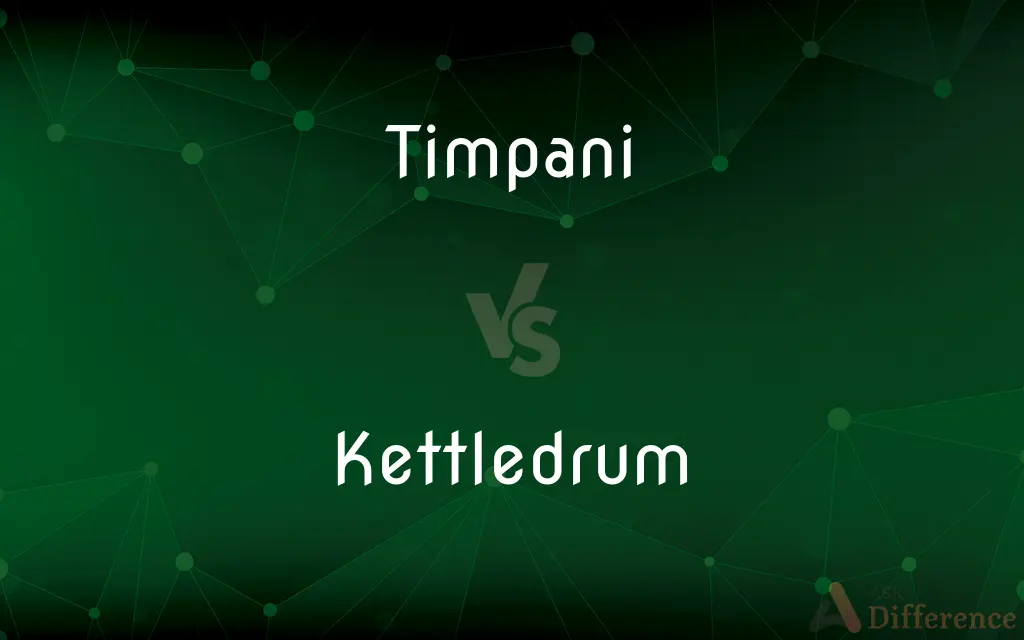Timpani vs. Kettledrum — What's the Difference?
By Maham Liaqat & Urooj Arif — Updated on March 18, 2024
Timpani, also known as kettledrums, are musical instruments in the percussion family, but "timpani" often refers to orchestral contexts, while "kettledrum" implies a broader use, including in bands.

Difference Between Timpani and Kettledrum
Table of Contents
ADVERTISEMENT
Key Differences
Timpani are percussion instruments known for their pitched sound, used primarily in orchestral settings to provide harmony and rhythm. They are played with mallets and have tunable pitches. Whereas kettledrums, often synonymous with timpani, are sometimes used in a broader context, including military and marching bands, emphasizing their versatility in different musical genres.
The term "timpani" is Italian, denoting a more classical and formal usage, particularly in symphony orchestras where they play a crucial role in the percussion section. On the other hand, "kettledrum" comes from the German word "Pauke," and its usage often extends to various ensembles beyond the classical orchestra, highlighting a more universal application.
Timpani are characterized by their large copper bowls and synthetic or animal skin heads, which contribute to their distinctive, resonant sound. They require precise tuning to specific notes for orchestral pieces. Conversely, kettledrums, while physically similar, may not always demand the same level of precision in tuning, especially in settings where pitch accuracy is less critical, like in some traditional or ceremonial music.
Orchestral timpani parts are often complex and integral to the composition, requiring significant skill and musical understanding from the player. This contrasts with the use of kettledrums in some non-orchestral contexts, where the parts might be simpler or serve a more rhythmic than melodic role.
The maintenance and setup of timpani for orchestral performance are meticulous, with attention to pitch, tone, and resonance. Kettledrums, while also maintained carefully, might be subjected to different conditions in outdoor performances or in marching bands, where durability can take precedence over acoustic perfection.
ADVERTISEMENT
Comparison Chart
Primary Context
Orchestral settings
Broader usage including military and marching bands
Tuning Precision
High precision in tuning for specific pitches
May not require as precise tuning
Role in Music
Provides harmony and rhythm, complex parts
Rhythmic role, simpler parts in some contexts
Maintenance
Meticulous for acoustic perfection
Durable, possibly less focused on acoustics
Origin of Term
Italian, classical connotation
German "Pauke," broader application
Compare with Definitions
Timpani
Known for their role in classical music, providing harmonic and rhythmic support.
She practiced the timpani part to perfect her contribution to the orchestral piece.
Kettledrum
Another term for timpani, often used in various musical contexts including marching bands.
The marching band's kettledrum player led the rhythm section with vigor.
Timpani
Played with mallets, allowing for a range of tones and dynamics.
The timpanist used softer mallets for a more subdued sound in the adagio section.
Kettledrum
Sometimes implies a less formal or classical setting than "timpani."
The folk band included a kettledrum for its deep, resonant sound.
Timpani
Large, copper bowl-shaped percussion instruments with tunable pitch, used in orchestras.
The timpani section added dramatic depth to the symphony's finale.
Kettledrum
Can be made from copper or brass, with a tunable membrane.
The kettledrum added a ceremonial touch to the event with its booming sound.
Timpani
Integral to the percussion section of symphony orchestras.
The timpani's thunderous rolls echoed in the concert hall during the performance.
Kettledrum
Played in a range of musical genres, from classical to contemporary.
Their music fusion project creatively incorporated the kettledrum.
Timpani
Requires skilled players for precise tuning and playing techniques.
The orchestra's timpanist meticulously tuned his instruments before the concert.
Kettledrum
Often part of military and ceremonial bands.
The military parade was accompanied by the steady beat of the kettledrum.
Timpani
Timpani (; Italian pronunciation: [ˈtimpani]) or kettledrums (also informally called timps) are musical instruments in the percussion family. A type of drum categorised as a hemispherical drum, they consist of a membrane called a head stretched over a large bowl traditionally made of copper.
Kettledrum
A large hemispherical drum, often made of copper or brass with a parchment head.
Timpani
(musical instruments) The set of precision kettledrums in an orchestra.
Kettledrum
(musical instruments) A large hemispherical brass percussion instrument (one of the timpani) with a drumhead that can be tuned by adjusting its tension.
Timpani
A large hemispherical brass or copper percussion instrument with a drumhead that can be tuned by adjusting the tension on it
Kettledrum
(dated) An informal social party at which a light collation is offered, held in the afternoon or early evening.
Kettledrum
A drum made of thin copper in the form of a hemispherical kettle, with parchment stretched over the mouth of it.
Kettledrum
A large hemispherical brass or copper percussion instrument with a drumhead that can be tuned by adjusting the tension on it
Common Curiosities
What is the difference between timpani and kettledrum?
Timpani and kettledrum essentially refer to the same percussion instruments, but "timpani" is more commonly used in classical orchestral contexts, while "kettledrum" can imply broader uses, including military and marching bands.
Do you need special skills to play the timpani?
Yes, playing the timpani requires significant skill, including the ability to tune them precisely, read music, and perform complex rhythms and dynamics.
Can timpani be tuned to different pitches?
Yes, timpani are designed to be tunable to specific pitches, which is crucial for their role in orchestral music.
Are kettledrums used in orchestras?
While "kettledrum" can refer to the same instruments as timpani, the term is often used in contexts outside of the classical orchestra, such as marching or military bands. However, they are physically the same and play similar roles in music.
Do timpani have a standard set of sizes?
While there is variability, orchestral timpani typically come in a range of standard sizes to cover different pitch ranges, usually including 23", 26", 29", and 32" diameters.
What mallets are used for playing timpani?
Timpani mallets come in various hardness levels, from very soft to very hard, and are typically made of felt-covered wooden or bamboo shafts. The choice of mallet affects the tone and volume produced.
Can the sound of timpani vary depending on the drumhead material?
Yes, the sound of timpani can vary based on whether the drumhead is made of animal skin, which produces a warmer tone, or synthetic materials, which offer more consistency and durability.
What materials are timpani made of?
Timpani are typically made with copper bowls and either synthetic or animal skin heads, contributing to their distinctive sound.
Is it difficult to transport timpani?
Timpani are large and somewhat cumbersome, making transportation challenging. Special cases and careful handling are required to move them safely, especially for performances outside of a permanent venue.
What genres of music include timpani?
Besides classical music, timpani can be found in film scores, some pop and rock arrangements, and in experimental music genres, where their dramatic sound adds depth and intensity.
What's the historical origin of the timpani?
Timpani have roots in ancient civilizations, including the Middle East and Europe, where they were used in ceremonies and military contexts. Their design and musical role evolved significantly over centuries.
Can timpani be played in solo performances?
Yes, there are solo pieces written for timpani, showcasing the instrument's range and the player's technique. Solo performances can highlight the timpani's musical versatility beyond its traditional orchestral role.
How do you tune timpani?
Timpani are tuned by adjusting the tension of the drumhead via a pedal mechanism or tuning keys, which changes the pitch. Players use their ears and sometimes electronic tuners to match specific notes.
What role do kettledrums play in military bands?
In military bands, kettledrums provide rhythmic support and musical emphasis, often marking tempo and adding ceremonial grandeur to parades, events, and rituals.
How are kettledrums used in non-Western music?
In some non-Western musical traditions, instruments similar to kettledrums are used in religious ceremonies, festivals, and as part of traditional ensembles, reflecting a wide cultural significance.
Share Your Discovery

Previous Comparison
Tie vs. Tied
Next Comparison
Abovementioned vs. AforementionedAuthor Spotlight
Written by
Maham LiaqatCo-written by
Urooj ArifUrooj is a skilled content writer at Ask Difference, known for her exceptional ability to simplify complex topics into engaging and informative content. With a passion for research and a flair for clear, concise writing, she consistently delivers articles that resonate with our diverse audience.














































